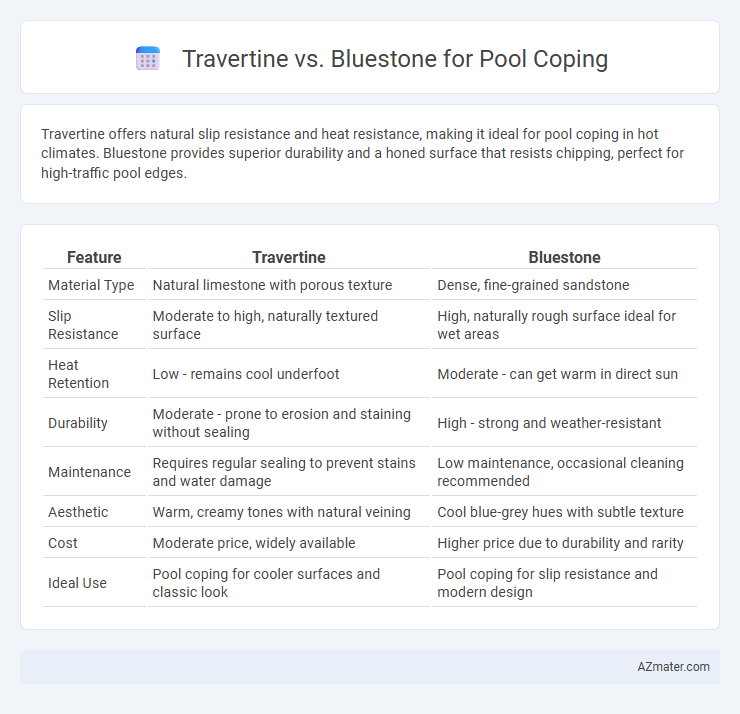Travertine offers natural slip resistance and heat resistance, making it ideal for pool coping in hot climates. Bluestone provides superior durability and a honed surface that resists chipping, perfect for high-traffic pool edges.
Table of Comparison
| Feature | Travertine | Bluestone |
|---|---|---|
| Material Type | Natural limestone with porous texture | Dense, fine-grained sandstone |
| Slip Resistance | Moderate to high, naturally textured surface | High, naturally rough surface ideal for wet areas |
| Heat Retention | Low - remains cool underfoot | Moderate - can get warm in direct sun |
| Durability | Moderate - prone to erosion and staining without sealing | High - strong and weather-resistant |
| Maintenance | Requires regular sealing to prevent stains and water damage | Low maintenance, occasional cleaning recommended |
| Aesthetic | Warm, creamy tones with natural veining | Cool blue-grey hues with subtle texture |
| Cost | Moderate price, widely available | Higher price due to durability and rarity |
| Ideal Use | Pool coping for cooler surfaces and classic look | Pool coping for slip resistance and modern design |
Introduction to Pool Coping Materials
Travertine and bluestone are popular choices for pool coping due to their durability and aesthetic appeal. Travertine offers a natural, porous texture that stays cool underfoot, making it ideal for hot climates, while bluestone provides a dense, non-slip surface with a sophisticated blue-gray hue. Selecting the right pool coping material balances comfort, safety, and design preferences to enhance the overall pool area.
What is Travertine?
Travertine is a natural limestone formed by mineral deposits from hot springs and is prized for its porous texture and warm, earthy tones, making it an ideal choice for pool coping due to its slip-resistant surface. Its durability and ability to stay cool underfoot in hot weather add to its suitability for outdoor use around pools. Compared to bluestone, travertine offers a softer, more classic aesthetic that blends seamlessly with Mediterranean or rustic design styles.
What is Bluestone?
Bluestone is a dense, durable sedimentary rock composed primarily of sandstone, known for its natural slip resistance and elegant blue-gray hues, making it a popular choice for pool coping. Its ability to withstand harsh weather conditions and resist heat retention provides safety and comfort around pools. Bluestone's textured surface offers superior traction, reducing the risk of slips, while its aesthetic versatility enhances the pool area with a timeless, sophisticated look.
Aesthetic Appeal: Travertine vs Bluestone
Travertine pool coping offers a warm, natural look with creamy beige tones and unique veining that complements Mediterranean and contemporary designs, while bluestone provides a sleek, modern aesthetic with its deep blue-gray hues and subtle texture. The porous nature of travertine creates a softer, more rustic appearance, ideal for creating an inviting poolside ambiance, whereas bluestone's dense, honed surface lends a polished, sophisticated feel to outdoor spaces. Both materials maintain their beauty through weathering, but bluestone tends to resist staining and fading better, preserving its rich color over time.
Slip Resistance and Safety
Travertine pool coping offers superior slip resistance due to its naturally textured surface, making it a safer option around wet areas. Bluestone, while aesthetically pleasing, tends to be smoother and can become slippery when wet, increasing the risk of slips and falls. For enhanced pool safety, travertine's porous composition provides better traction, reducing accidents compared to bluestone.
Durability and Longevity
Travertine pool coping offers excellent durability with natural resistance to heat, slips, and cracks, making it ideal for high-traffic pool areas. Bluestone is recognized for its dense composition and superior strength, providing long-lasting performance even under harsh weather conditions. Both materials ensure longevity, but travertine's porous nature requires sealing to maintain its durability over time.
Heat Retention and Comfort
Travertine offers excellent heat retention properties, maintaining a cooler surface under direct sunlight, which enhances barefoot comfort around pools. Bluestone tends to absorb and retain more heat, making it warmer to the touch during hot weather, potentially causing discomfort. Choosing Travertine for pool coping ensures a more pleasant and safer poolside experience, especially in sunny climates.
Maintenance Requirements
Travertine pool coping demands regular sealing to prevent water absorption and staining, ensuring longevity and aesthetic appeal. Bluestone requires less frequent sealing due to its denser composition, making it more resistant to moisture and surface damage. Both materials benefit from routine cleaning with mild detergents and avoiding harsh chemicals to maintain their natural texture and color.
Cost Comparison
Travertine pool coping typically costs between $15 to $30 per square foot, making it a mid-range option known for durability and natural beauty. Bluestone, on the other hand, varies from $20 to $40 per square foot, often reflecting its denser composition and slip-resistant surface. When comparing costs, travertine offers a more budget-friendly alternative while bluestone demands a higher investment due to its premium features.
Choosing the Best Option for Your Pool
Travertine offers a natural, warm appearance with excellent heat resistance and slip resistance, making it an ideal choice for pool coping in hot climates. Bluestone features a denser, harder surface with a unique blue-gray hue that provides durability and a non-porous texture, reducing stain risk and requiring less maintenance. Compare factors such as climate, maintenance preferences, and aesthetic goals when choosing between travertine and bluestone to ensure the best fit for your pool area's safety and style.

Infographic: Travertine vs Bluestone for Pool Coping
 azmater.com
azmater.com